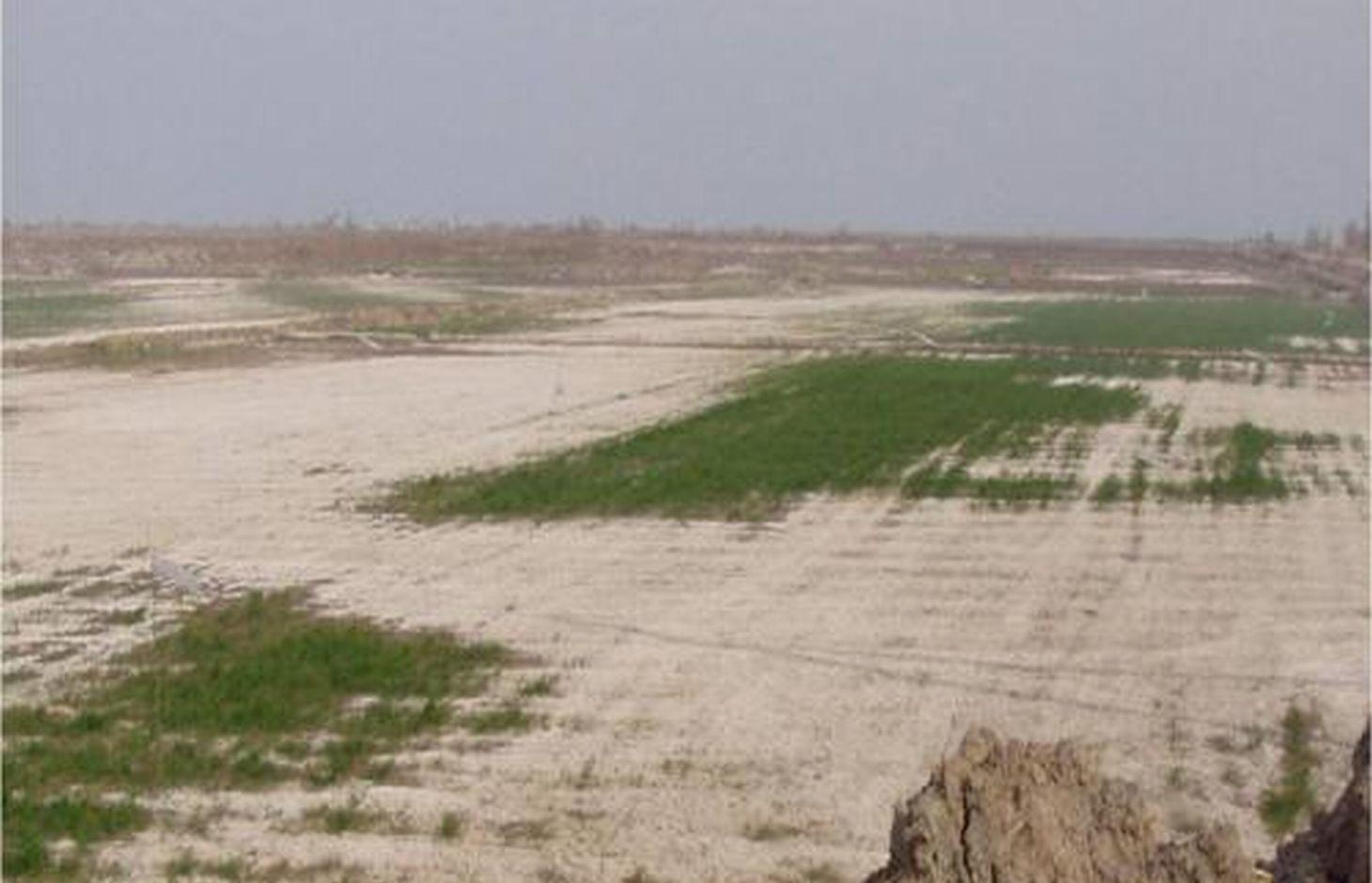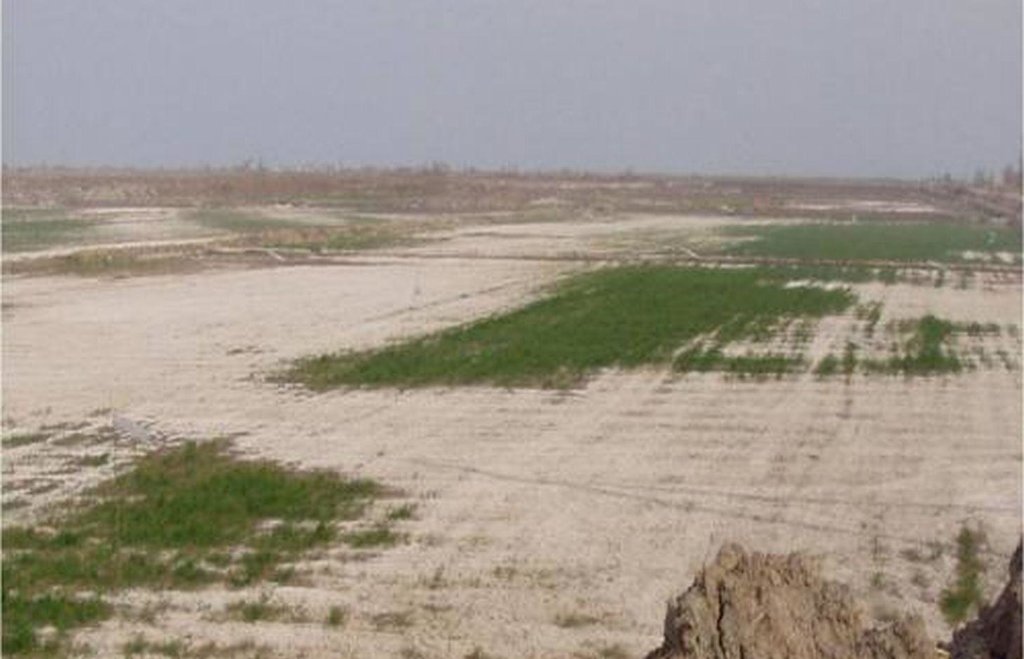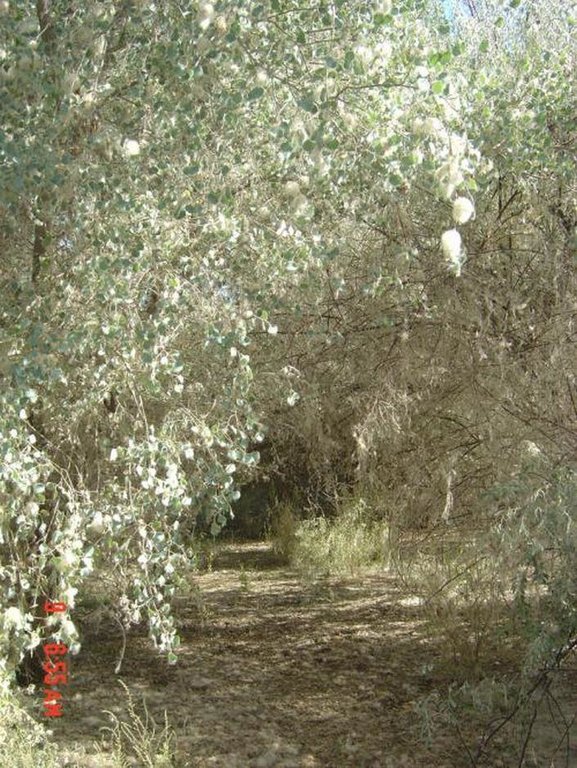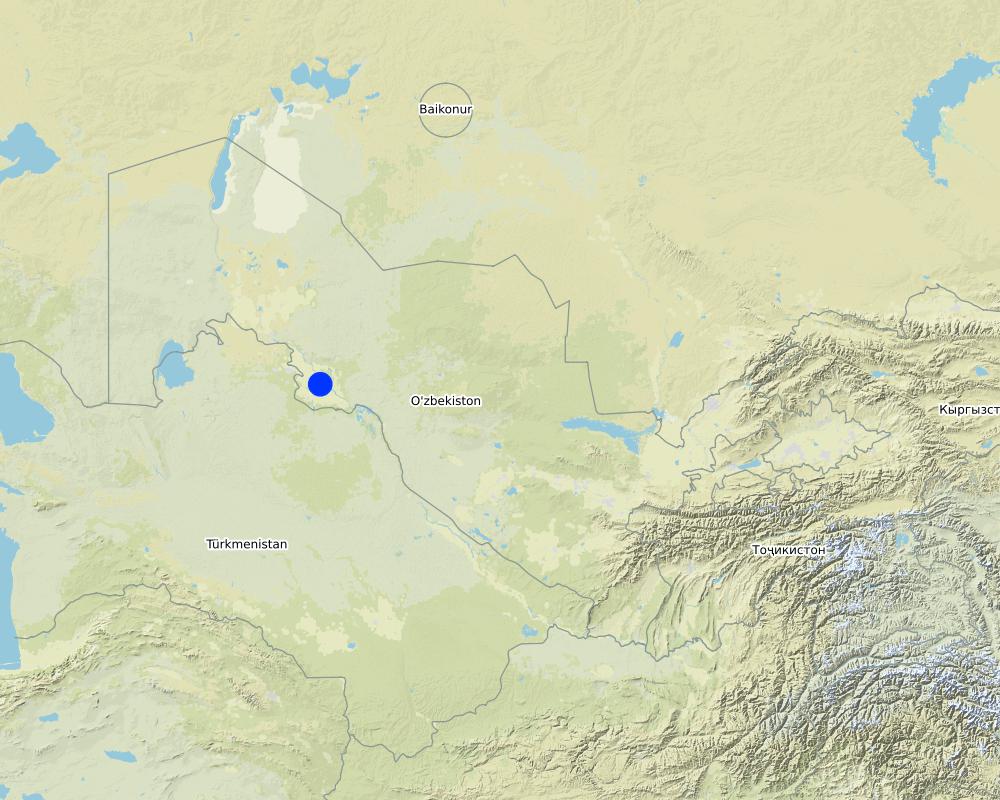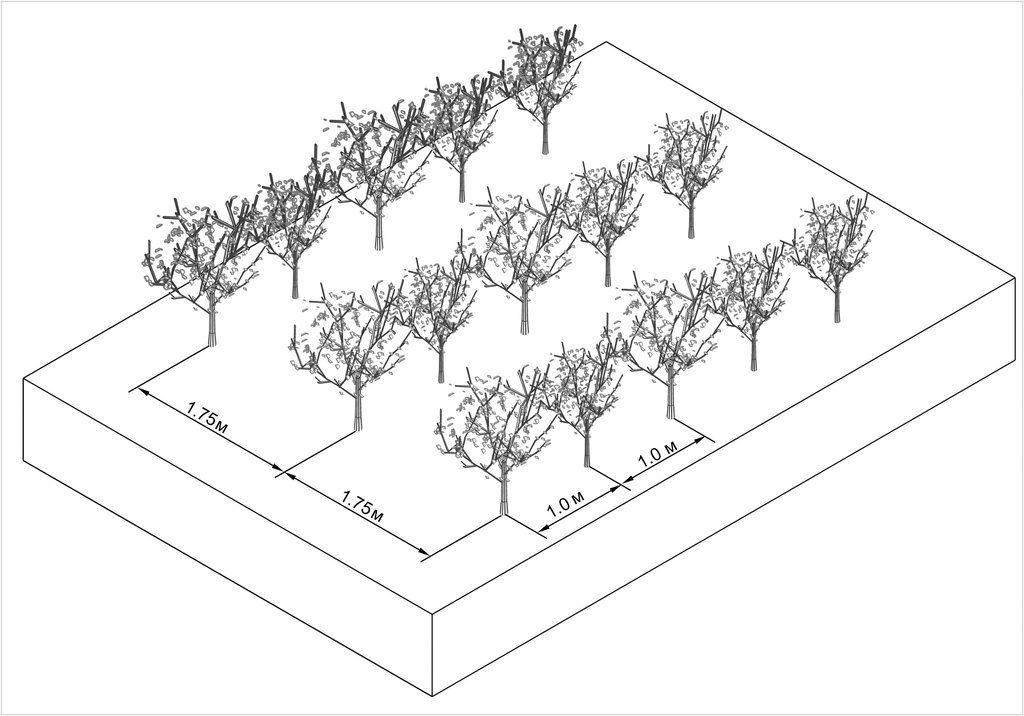Afforestation for rehabilitation of degraded irrigated croplands (CACILM) [Uzbekistan]
- Creation:
- Update:
- Compiler: Rustam Ibragimov
- Editor: –
- Reviewers: Alexandra Gavilano, David Streiff, Rima Mekdaschi Studer
Central Asia Countries' Initiatives for Land Management (CACILM)
technologies_1533 - Uzbekistan
- Full summary as PDF
- Full summary as PDF for print
- Full summary in the browser
- Full summary (unformatted)
- Afforestation for rehabilitation of degraded irrigated croplands (CACILM): April 28, 2017 (inactive)
- Afforestation for rehabilitation of degraded irrigated croplands (CACILM): Aug. 2, 2017 (inactive)
- Afforestation for rehabilitation of degraded irrigated croplands (CACILM): Aug. 22, 2019 (inactive)
- Afforestation for rehabilitation of degraded irrigated croplands (CACILM): Nov. 25, 2019 (public)
View sections
Expand all Collapse all1. General information
1.2 Contact details of resource persons and institutions involved in the assessment and documentation of the Technology
SLM specialist:
Khamzina Asiya
Project ZEF
Germany
Name of the institution(s) which facilitated the documentation/ evaluation of the Technology (if relevant)
Central Asian Countries Initiative for Sustainable Land Management - Multicountry Capacity Building (CACILM - MCB) - KyrgyzstanName of the institution(s) which facilitated the documentation/ evaluation of the Technology (if relevant)
Research Institute of Karakul Breeding and Desert Ecology of Uzbekistan - UzbekistanName of the institution(s) which facilitated the documentation/ evaluation of the Technology (if relevant)
Center for Development Research (ZEF) (Center for Development Research (ZEF)) - Germany1.3 Conditions regarding the use of data documented through WOCAT
The compiler and key resource person(s) accept the conditions regarding the use of data documented through WOCAT:
Yes
1.5 Reference to Questionnaire(s) on SLM Approaches (documented using WOCAT)
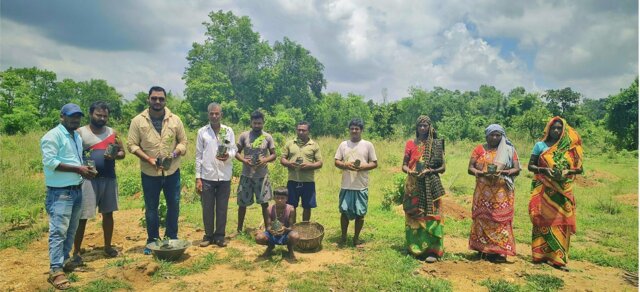
Community-led participatory and self sustainable land restoration in … [India]
A community-led participatory approach is being implemented in West Bengal to revive and regenerate a broken and degraded landscape through sustainable land management. Local people take the lead in both action and the development of a long-term management plan.
- Compiler: DIYA BANERJEE
2. Description of the SLM Technology
2.1 Short description of the Technology
Definition of the Technology:
A plantation of salinity-tolerant tree species, mostly having nitrogen fixing and high biodrainage capability, is created in a plot of arable land, out of use due to high salinity and water logging in order to restore productive functions of the land.
2.2 Detailed description of the Technology
Description:
Uzbekistan has many places where growing of staple crops in degraded (marginal) arable land is unprofitable, and even detrimental. Planting multi-purpose tree species in such lands can facilitate soil fertility restoration and the re-initiation of agricultural production. Abandoned land starts producing financial benefits by providing the population with wood for fuel and construction, medicines, edible fruits, foliar forage and other products. The effective selection of tree species can improve ecological services such as the reduction of water logging through transpiration (biodrainage); reduction of soil salinity, increase of soil nitrogen availability through nitrogen fixing and organic matter from leaf litter. In the long run, the plots of land may again be returned into the category of arable land (rotational agroforestry) or continue being used for forest plantations (in the frame of CACILM).
Purpose of the Technology: To increase the productivity of agricultural lands, rehabilitate agroecosystems and improve rural livelihoods through introduction of tree plantations on agricultural land
Establishment / maintenance activities and inputs: The most important component for the creation of tree plantations in marginal land is the selection of multi-purpose tree species with a variety of criteria, the main ones being salinity and drought tolerance as well as high biodrainage and nitrogen fixing capacity. Recommendations for Khorezm include three species, namely: oleaster (Elaeagnus angustifolia) a nitrogen fixing species, Turanga poplar (Populus euphratica) a fast-growing species, and Siberian elm (Ulmus pumila) a resilient species. Land preparation includes plot leveling, plowing and the leaching of salt. Seedlings of different species are planted according to a 1х1.75 m layout of unmixed rows, with species alternating every 5-7 rows. Dense planting allows for the harvesting of biomass by thinning the first years’ growth (for fuel and foliar forage). Gradually, the width between each row increases up to 3-5 meters. In the future, biomass is harvested through the sustainable trimming of tree limbs. During the first 2 years, a reduced irrigation rate is applied (10-30% less). After that, no irrigation is applied and trees are sustained by groundwater
Natural / human environment: The technology is adapted to the conditions of Khorezm oblast, Uzbekistan, an ancient irrigated oasis in the lower reaches of the Amu Darya River. The area features an extremely flat terrain with poor drainage of groundwater. Due to natural conditions and improper use of water and land resources, the land is affected by high salinity and water logging. The main occupation of the local population is the cultivation of cotton, winter wheat, vegetables, gourds and melons. Farmers, the main landowners, own the land on the basis of long-term rent. For the farmers, reclamation through agroforestry is an inexpensive and uncomplicated technology for combating land degradation, which they can introduce independently and receive economic benefits
2.3 Photos of the Technology
2.5 Country/ region/ locations where the Technology has been applied and which are covered by this assessment
Country:
Uzbekistan
Region/ State/ Province:
Uzbekistan / Korezm oblast
Further specification of location:
Yangibazar district
Specify the spread of the Technology:
- evenly spread over an area
Comments:
Total area covered by the SLM Technology is 0.02 km2.
A plot of arable land was put out of agricultural production due to high salinity and water logging.
Map
×2.6 Date of implementation
If precise year is not known, indicate approximate date:
- less than 10 years ago (recently)
2.7 Introduction of the Technology
Specify how the Technology was introduced:
- through projects/ external interventions
Comments (type of project, etc.):
Introduced under the project of UNESCO/ ZEF (Bonn)/Urgench University in 2003
3. Classification of the SLM Technology
3.1 Main purpose(s) of the Technology
- improve production
- reduce, prevent, restore land degradation
3.2 Current land use type(s) where the Technology is applied
Land use mixed within the same land unit:
Yes
Specify mixed land use (crops/ grazing/ trees):
- Agroforestry

Cropland
- Annual cropping
- Perennial (non-woody) cropping
- Tree and shrub cropping
Annual cropping - Specify crops:
- fibre crops - cotton
- cereals - wheat (winter)
- root/tuber crops - potatoes
- melon, gourds
Tree and shrub cropping - Specify crops:
- grapes
- stone fruits (peach, apricot, cherry, plum, etc)
- pome fruits (apples, pears, quinces, etc.)
Number of growing seasons per year:
- 1
Specify:
Longest growing period in days: 230; Longest growing period from month to month: from October-June - winter wheat; Second longest growing period in days: 160; Second longest growing period from month to month: July-October - double crops following winter wheat

Grazing land
Animal type:
- goats
- cattle - dairy
Comments:
Major land use problems (compiler’s opinion): It is difficult to rehabilitate saline marginal lands using common methods of winter-spring leaching.
Major land use problems (land users’ perception): Salinity is hard to address.
Mixed: (eg agro-pastoralism, silvo-pastoralism): Cows and goats are prevalent.
Grazingland comments: Within the irrigated zone, livestock grazes on the isolation space along canals, roads and collectors. There are no specialized pastures.
Future (final) land use (after implementation of SLM Technology): Mixed: Mf: Agroforestry
Type of cropping system and major crops comments: 70-80% of irrigated plough land is occupied by cotton and winter wheat in almost equal proportion
Livestock is grazing on crop residues
Type of grazing system comments: Within the irrigated zone, livestock grazes on the isolation space along canals, roads and collectors. There are no specialized pastures.
3.3 Has land use changed due to the implementation of the Technology?
Has land use changed due to the implementation of the Technology?
- Yes (Please fill out the questions below with regard to the land use before implementation of the Technology)
Land use mixed within the same land unit:
Yes
Specify mixed land use (crops/ grazing/ trees):
- Agroforestry

Cropland
Comments:
Future (final) land use (after implementation of SLM Technology): Mixed: Mf: Agroforestry
Type of cropping system and major crops comments: 70-80% of irrigated plough land is occupied by cotton and winter wheat in almost equal proportion
Livestock is grazing on crop residues
Type of grazing system comments: Within the irrigated zone, livestock grazes on the isolation space along canals, roads and collectors. There are no specialized pastures.
If land use has changed due to the implementation of the Technology, indicate land use before implementation of the Technology:
Cropland: Ca: Annual cropping
3.4 Water supply
Water supply for the land on which the Technology is applied:
- full irrigation
3.5 SLM group to which the Technology belongs
- improved ground/ vegetation cover
- improved plant varieties/ animal breeds
3.6 SLM measures comprising the Technology

vegetative measures
- V1: Tree and shrub cover

management measures
- M1: Change of land use type
Comments:
Type of vegetative measures: aligned: -linear
3.7 Main types of land degradation addressed by the Technology

chemical soil deterioration
- Cn: fertility decline and reduced organic matter content (not caused by erosion)
- Cs: salinization/ alkalinization

physical soil deterioration
- Pw: waterlogging

biological degradation
- Bl: loss of soil life
Comments:
Main type of degradation addressed: Cn: fertility decline and reduced organic matter content, Pw: waterlogging, Bl: loss of soil life
Secondary types of degradation addressed: Cs: salinisation / alkalinisation
Main causes of degradation: other human induced causes (specify) (Inadequate operation of artificial drainage, nonobservance of irrigation rates), other natural causes (avalanches, volcanic eruptions, mud flows, highly susceptible natural resources, extreme topography, etc.) specify (Highly complicated conditions for ground water drainage due to the flatness of the terrain (almost zero slope)), poverty / wealth (Insufficient funds for rehabilitation and maintenance of irrigation and drainage infrastructure)
Secondary causes of degradation: soil management (Failure to follow agrotechnical practices for the treatment of soil), education, access to knowledge and support services (Low capacity of the land users)
3.8 Prevention, reduction, or restoration of land degradation
Specify the goal of the Technology with regard to land degradation:
- restore/ rehabilitate severely degraded land
Comments:
Secondary goals: prevention of land degradation, mitigation / reduction of land degradation
4. Technical specifications, implementation activities, inputs, and costs
4.1 Technical drawing of the Technology
Technical specifications (related to technical drawing):
Seedlings of different species are planted according to a 1х1,75 layout in unmixed rows with species alternating every 5-7 rows. As a result of gradual thinning in order to harvest the biomass, the width between rows increases up to 3-5 m, which is quite enough for mature trees
Location: Yangibazar district. Yangibazar district/Khorezm oblas
Date: 10-09-2011
Technical knowledge required for field staff / advisors: moderate
Technical knowledge required for land users: moderate
Main technical functions: improvement of ground cover, increase in organic matter, increase in nutrient availability (supply, recycling,…), increase of biomass (quantity)
Aligned: -linear
Vegetative material: T : trees / shrubs
Number of plants per (ha): 5714
Vertical interval between rows / strips / blocks (m): 0.0001
Spacing between rows / strips / blocks (m): 1.75
Width within rows / strips / blocks (m): 1
Trees/ shrubs species: Turanga poplar (P.euphratica), Siberian elm (U.pumila) planted
Fruit trees / shrubs species: oleaster (E.angustifolia) planted
Slope (which determines the spacing indicated above): 0.01%
Change of land use type: arable land changed to plantations of perennial trees
Author:
R. Ibragimov, UZGIP Institute, 44, Navoi str., Tashkent, Uzbekistan
4.2 General information regarding the calculation of inputs and costs
Specify currency used for cost calculations:
- USD
other/ national currency (specify):
Узбекский сум
Indicate average wage cost of hired labour per day:
10.00
4.3 Establishment activities
| Activity | Timing (season) | |
|---|---|---|
| 1. | Leveling | Autumn |
| 2. | Tillage | Autumn |
| 3. | Leaching | February - March |
| 4. | Chiseling | March |
| 5. | Planting | March |
4.4 Costs and inputs needed for establishment
| Specify input | Unit | Quantity | Costs per Unit | Total costs per input | % of costs borne by land users | |
|---|---|---|---|---|---|---|
| Labour | Leveling | machine/hr/ha | 1.5 | 9.6 | 14.4 | 100.0 |
| Labour | Tillage | machine/hr/ha | 1.5 | 19.266 | 28.9 | 100.0 |
| Labour | Leaching | machine/hr/ha | 4.4 | 2.75 | 12.1 | 100.0 |
| Labour | Chiseling | machine/hr/ha | 1.0 | 11.6 | 11.6 | 100.0 |
| Plant material | Seedlimgs | pieces/ha | 5714.0 | 0.57777 | 3301.38 | |
| Construction material | Labour: Leaching | persons/day/ha | 0.5 | 11.6 | 5.8 | 100.0 |
| Construction material | Labour: Planting | persons/day/ha | 115.0 | 1.507 | 173.3 | |
| Total costs for establishment of the Technology | 3547.48 | |||||
| Total costs for establishment of the Technology in USD | 3547.48 | |||||
Comments:
Duration of establishment phase: 3 month(s)
4.5 Maintenance/ recurrent activities
| Activity | Timing/ frequency | |
|---|---|---|
| 1. | Irrigations and care | 5-6 times. vegetation |
4.6 Costs and inputs needed for maintenance/ recurrent activities (per year)
| Specify input | Unit | Quantity | Costs per Unit | Total costs per input | % of costs borne by land users | |
|---|---|---|---|---|---|---|
| Labour | Irrigations and care | machine/hr/ha | 270.0 | 0.963 | 260.01 | 100.0 |
| Labour | Irrigations and care | persons/day/ha | 6.0 | 3.133 | 18.8 | 100.0 |
| Total costs for maintenance of the Technology | 278.81 | |||||
| Total costs for maintenance of the Technology in USD | 278.81 | |||||
Comments:
The cost is estimated per hectare (as of 2009). Current costs are defined based on the assumption that irrigation and care will be provided by a single person over 9 months. After 2 years, irrigation ceases and the trees must survive in the natural habitat.
4.7 Most important factors affecting the costs
Describe the most determinate factors affecting the costs:
Most costs are incurred in the procurement of seedlings. The cost of hired labour required to plant the seedlings is also high. However, the tradition of community-based voluntary activities to help implement social projects (the khashars) may help in reducing the cost of planting considerably.
5. Natural and human environment
5.1 Climate
Annual rainfall
- < 250 mm
- 251-500 mm
- 501-750 mm
- 751-1,000 mm
- 1,001-1,500 mm
- 1,501-2,000 mm
- 2,001-3,000 mm
- 3,001-4,000 mm
- > 4,000 mm
Specifications/ comments on rainfall:
Total amount of precipitation is 94mm/year. 70% of precipitation falls from November to March.
Agro-climatic zone
- semi-arid
Thermal climate class: temperate. During 4 months. air t<5°Сand during 7 months. air tis>10°С
For 150 days
5.2 Topography
Slopes on average:
- flat (0-2%)
- gentle (3-5%)
- moderate (6-10%)
- rolling (11-15%)
- hilly (16-30%)
- steep (31-60%)
- very steep (>60%)
Landforms:
- plateau/plains
- ridges
- mountain slopes
- hill slopes
- footslopes
- valley floors
Altitudinal zone:
- 0-100 m a.s.l.
- 101-500 m a.s.l.
- 501-1,000 m a.s.l.
- 1,001-1,500 m a.s.l.
- 1,501-2,000 m a.s.l.
- 2,001-2,500 m a.s.l.
- 2,501-3,000 m a.s.l.
- 3,001-4,000 m a.s.l.
- > 4,000 m a.s.l.
Comments and further specifications on topography:
Slopes on average: This terrain has practically zero slope
Altitudinal zone: Elevation above sea level is about 100 m.
5.3 Soils
Soil depth on average:
- very shallow (0-20 cm)
- shallow (21-50 cm)
- moderately deep (51-80 cm)
- deep (81-120 cm)
- very deep (> 120 cm)
Soil texture (topsoil):
- medium (loamy, silty)
- fine/ heavy (clay)
Topsoil organic matter:
- low (<1%)
If available, attach full soil description or specify the available information, e.g. soil type, soil PH/ acidity, Cation Exchange Capacity, nitrogen, salinity etc.
Soil depth on average: Deep grassland-alluvial soils
Soil texture (topsoil): Medium- and light-loamy, layered soils with stratums of clay (medium) and loamy soils with stratums of sand (fine/heavy)
Topsoil organic matter: Topsoil organic matter is approximately 0.7-0.8%
Soil fertility is low (20-30 points from a 100- point scale)
Soil drainage / infiltration is poor (soil water permeability is around 3mm/hr due to compaction)
Soil water storage capacity is medium (minimum water retention capacity of the soil is 20-30% of the volume)
5.4 Water availability and quality
Ground water table:
on surface
Availability of surface water:
excess
Water quality (untreated):
for agricultural use only (irrigation)
Comments and further specifications on water quality and quantity:
Ground water table: 50-80 cm from the surface
Availability of surface water: In March, after leaching of the soil from salinity and during the summer during the irrigation period
Water quality (untreated): Mineralization is 3-4 g/liter
5.5 Biodiversity
Species diversity:
- low
Comments and further specifications on biodiversity:
After the withdrawal of the plot from agricultural production, vegetation is mainly pseudo steppe weeds.
5.6 Characteristics of land users applying the Technology
Market orientation of production system:
- mixed (subsistence/ commercial)
Off-farm income:
- less than 10% of all income
Individuals or groups:
- individual/ household
Level of mechanization:
- manual work
- mechanized/ motorized
Gender:
- men
Indicate other relevant characteristics of the land users:
Land users applying the Technology are mainly common / average land users
Population density: 200-500 persons/km2
Annual population growth: 1% - 2%
Market orientation of production system: Part of the output is sold in bazars and part of the output is consumed by the household
Level of mechanization: Tractor and agricultural implements: plow. chisel. how. harrow. planting machine. Manual work is used to care after the crops (weeding. thinning).
5.7 Average area of land used by land users applying the Technology
- < 0.5 ha
- 0.5-1 ha
- 1-2 ha
- 2-5 ha
- 5-15 ha
- 15-50 ha
- 50-100 ha
- 100-500 ha
- 500-1,000 ha
- 1,000-10,000 ha
- > 10,000 ha
Is this considered small-, medium- or large-scale (referring to local context)?
- medium-scale
Comments:
Average area of land owned or leased by land users applying the Technology: Also 5-15 ha
Currently, farm consolidation is ongoing
5.8 Land ownership, land use rights, and water use rights
Land ownership:
- state
Land use rights:
- leased
- individual
Comments:
Farmers own the land on the basis of long-term (50 years) rent without the right of sale and inheritance. Dekhkan households (up to 2 hectares) have private ownership of the land
5.9 Access to services and infrastructure
health:
- poor
- moderate
- good
education:
- poor
- moderate
- good
technical assistance:
- poor
- moderate
- good
employment (e.g. off-farm):
- poor
- moderate
- good
markets:
- poor
- moderate
- good
energy:
- poor
- moderate
- good
roads and transport:
- poor
- moderate
- good
drinking water and sanitation:
- poor
- moderate
- good
financial services:
- poor
- moderate
- good
6. Impacts and concluding statements
6.1 On-site impacts the Technology has shown
Socio-economic impacts
Production
wood production
Comments/ specify:
Construction wood in the outlook
production area
Comments/ specify:
Abandoned land is returned into the agricultural production system
energy generation
Comments/ specify:
Energy value of biomass obtained as a result of thinning of 5-year old plantations down to the density of 2300 trees/hectare was 8-19 ton/hectare.
Water availability and quality
demand for irrigation water
Comments/ specify:
Irrigation of the plantations is done for 2 years at reduced rates
Income and costs
farm income
Comments/ specify:
Unprofitable land would start bringing benefit
diversity of income sources
Comments/ specify:
Construction and fuel wood, foliar forage for the animals
Socio-cultural impacts
health situation
Comments/ specify:
Converting degraded arable land into forest plantation would improve the ecosystem, indirectly impacting people’s health
cultural opportunities
Comments/ specify:
Land overgrown with weed plants becomes a green tree plantation
livelihood and human well-being
Comments/ specify:
The technology in question provides additional income to the land users; improved environmental conditions indirectly facilitates an improvement in the population’s health.
Ecological impacts
Water cycle/ runoff
excess water drainage
Comments/ specify:
Bio drainage through transpiration
Soil
soil cover
Comments/ specify:
Salt efflorescence on the soil surface disappeared
nutrient cycling/ recharge
Comments/ specify:
Increase of nitrogen level by 6-30% through nitrogen fixation by root nodule bacterium (in 5 years)
soil organic matter/ below ground C
Comments/ specify:
Increase by 20% (2-7 t/hectare) in the form of fallen leaves (in 5 years)
Biodiversity: vegetation, animals
biomass/ above ground C
Comments/ specify:
Growth of surface biomass is 20 t/hectare/year
Other ecological impacts
Carbon sequestration in biomass and soil
Comments/ specify:
10-20t/hectare already on the 5th year of development
6.2 Off-site impacts the Technology has shown
impact of greenhouse gases
Comments/ specify:
The reduction of atmospheric СО2.
Through sequestration in the biomass of tree plantations is a contribution to the common goal of addressing global warming
6.3 Exposure and sensitivity of the Technology to gradual climate change and climate-related extremes/ disasters (as perceived by land users)
Gradual climate change
Gradual climate change
| Season | increase or decrease | How does the Technology cope with it? | |
|---|---|---|---|
| annual temperature | increase | not known |
Climate-related extremes (disasters)
Meteorological disasters
| How does the Technology cope with it? | |
|---|---|
| local rainstorm | not known |
| local windstorm | not known |
Climatological disasters
| How does the Technology cope with it? | |
|---|---|
| drought | not known |
Hydrological disasters
| How does the Technology cope with it? | |
|---|---|
| general (river) flood | not known |
Other climate-related consequences
Other climate-related consequences
| How does the Technology cope with it? | |
|---|---|
| reduced growing period | not known |
| Reduction of ground water tabl | not well |
Comments:
The reduction of ground water table to below 3-5 meters would be a problem, because after 2 years, irrigation ceases and the trees must sustain themselves on groundwater
6.4 Cost-benefit analysis
How do the benefits compare with the establishment costs (from land users’ perspective)?
Short-term returns:
negative
Long-term returns:
very positive
How do the benefits compare with the maintenance/ recurrent costs (from land users' perspective)?
Short-term returns:
slightly positive
Long-term returns:
very positive
Comments:
In the short run, the benefit is brought in the form of foliar forage and fuel wood from thinning of plantations, while in the long term the benefits include wood for construction.
6.5 Adoption of the Technology
- single cases/ experimental
If available, quantify (no. of households and/ or area covered):
1 household
Of all those who have adopted the Technology, how many did so spontaneously, i.e. without receiving any material incentives/ payments?
- 0-10%
Comments:
1 land user families have adopted the Technology with external material support
There is no trend towards spontaneous adoption of the Technology
Comments on adoption trend: Possibly, rent-based land use does not stimulate farmers to make long-term investments. Farmers lack an understanding that abandoned lands may bring benefits to the owner in the long run, during the first 3-5 years. The method needs to be promoted.
6.7 Strengths/ advantages/ opportunities of the Technology
| Strengths/ advantages/ opportunities in the land user’s view |
|---|
|
An easy way to restore land productivity How can they be sustained / enhanced? Assistance in organizing the planting (seedlings) and increasing knowledge on afforestation |
| Strengths/ advantages/ opportunities in the compiler’s or other key resource person’s view |
|---|
|
Restored production of abandoned land using a simple method. This technology is based on traditional methods in tree cultivation. How can they be sustained / enhanced? To conduct propaganda and agitation among the farmers to use agroforestry on the degraded lands |
|
Local material (tree species) were used. How can they be sustained / enhanced? To select trees of native species with the desired properties |
|
Tree plantations were created using a low amount of irrigation water. How can they be sustained / enhanced? To teach the farmers to apply reduced volume of irrigation |
|
Represents inexpensive and ecologically friendly means to combat water logging using bio drainage. How can they be sustained / enhanced? To use trees with high biodrainage capacity |
|
Has multiple purposes: ecological benefits include carbon sequestration and improvement of soil quality, economic ones include resources for fuel and construction, as well as additional livestock forage. How can they be sustained / enhanced? To promote among the farmers the advantages and benefits of technology |
6.8 Weaknesses/ disadvantages/ risks of the Technology and ways of overcoming them
| Weaknesses/ disadvantages/ risks in the land user’s view | How can they be overcome? |
|---|---|
| No extra funds for long-term investment | Financial assistance from the government |
| Weaknesses/ disadvantages/ risks in the compiler’s or other key resource person’s view | How can they be overcome? |
|---|---|
| Long period of waiting for the main benefits. | During the first few years, it is possible to grow salt-tolerant crops in the inter-row space. Due to the thinning and pruning dense plantation will give fuels, livestock feed and reduce the waiting period for main benefits |
| Insufficient interest/motivation in farmers. | Encouraging farmers, rehabilitating marginal lands |
7. References and links
7.1 Methods/ sources of information
7.2 References to available publications
Title, author, year, ISBN:
A.Khamzina, J.P.A.Lamers 2011, Conversion of degraded arable land to forest plantations for the agroecosystem rehabilitation and improving population livelihood. A chapter in the book: “Cotton, Water, Salt and Som ”- Economic and Ecological Restructuring of Land- and Water Use in the Region Khorezm (Uzbekistan). A Pilot Project Springer. DOI 10.1007/978-94-007-1963-7_15 (in English)
Links and modules
Expand all Collapse allLinks

Community-led participatory and self sustainable land restoration in … [India]
A community-led participatory approach is being implemented in West Bengal to revive and regenerate a broken and degraded landscape through sustainable land management. Local people take the lead in both action and the development of a long-term management plan.
- Compiler: DIYA BANERJEE
Modules
No modules


